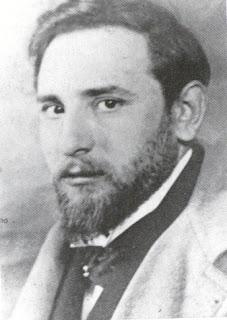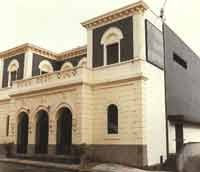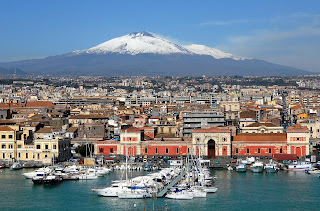Journalist and playwright whose movies inspired post-war neorealism
 |
| Nino Martoglio is considered by some as the founder of Sicilian theatre |
Martoglio is widely considered to be Sicily’s finest dialect playwright and by some to be the founder of Sicilian theatre. He was also an acclaimed poet, basing a good deal of his verse on the everyday conversations of working class Sicilians, written to amuse. His collection, Centona, is still sold today.
Later in a career that was ended abruptly by his death in an accident, Martoglio directed a number of silent films, the style of some of which prompted critics to describe them as forerunners of the post-war neorealism movement.
The son of a journalist and a school teacher, Martoglio studied sailing as a young man and obtained a captain’s licence. Yet he sought a career in journalism and joined the editorial staff of La Gazzetta di Catania, a daily newspaper founded by his father, Luigi.
In 1889, he launched a weekly magazine, D’Artagnan, a Sicilian language periodical devoted to art, literature and theatre, sharp political satire and the plight of the people of Civita, a poor neighbourhood in Catania which suffered particular deprivation. It also proved to be a useful vehicle for the poems that would eventually be gathered together in the Centona collection.
Theatre began to occupy most of Martoglio's attention from around the turn of the century. In 1901, he created the Sicilian Dramatic Company, which thanks to the talents of actors such as Angelo Musco, Giovanni Grasso, Virginia Balistrieri and others enjoyed success with Sicilian language productions even in Milan, where they performed at the Teatro Manzoni in 1903. The company’s productions of comedies written by a young Sicilian playwright, Pier Maria Rosso di San Secondo, were especially popular, among them San Giovanni Decapitato - Saint John the Beheaded - which he later turned into a film.
 |
| Martoglio staged the first theatrical works of Luigi Pirandello (above) |
In 1910, he founded the first "Teatro Minimo" in Rome at the Teatro Metastasio. He staged one-act plays from the Italian and foreign repertoire, as well as bringing to the stage the first theatrical works of Luigi Pirandello, by then famous as a novelist and a future Nobel Prize winner. Their collaborations included A vilanza (la bilancia) and Cappidazzu pava tutu.
Martoglio’s venture into cinema spanned two years from 1913-14. He directed the actress Pina Menichelli, one of the so-called ‘three divas’ of Italian silent movies, in Il romanzo and followed it with Capitan Blanco, Sperduti nel buio, for which he wrote the screenplay and directed in collaboration with Roberto Danesi, and Teresa Raquin.
All his screen work emphasised the gulf in Italian society between wealth and poverty and Sperduti nel buio - Lost in the Dark - which starred Grasso and Balistrieri - veterans of Martoglio’s original company in Catania - came to be regarded as a classic of the silent film era, representative of a small number of films that made up the realismo movement in Italian cinema.
In the 1930s, the film critic and lecturer Umberto Barbaro enthusiastically showed Sperduti nel buio in his classes at Centro Sperimentale di Cinematografia in Rome, where his students included Roberto Rossellini and Luchino Visconti, who would go on to become leading figures in the neorealism film movement after the Second World War.
 |
| The bust of Martoglio in the Bellini Gardens |
His body was laid to rest at the Campo Verano monumental cemetery in the Tiburtino quarter in Rome, not far from the Basilica di San Lorenzo fuori le mura. The cemetery is notable as the burial place of hundreds of illustrious figures from the artistic, historical, literary, musical and cinematographic world.
Although his films were lost, presumably stolen or destroyed during World War Two, Martoglio’s nieces, Vincenza and Angela, took steps to preserve their uncle’s manuscripts. There is a monumental bust of him in the Bellini Gardens in Catania, a short distance from the Teatro Metropolitan.
 |
| The Teatro Comunale Nino Martoglio in Belpasso |
The town of Belpasso, where Martoglio was born, has a population of 28,000. Located about 10km (six miles) northwest of the city of Catania, it has something of a chequered history, having twice been destroyed by the forces of nature and repositioned in consequence. In 1669, it was buried in lava following an eruption of the Mount Etna volcano which looms over Catania. Rebuilt in another location at a lower level, it was then badly damaged by an earthquake in 1693 and abandoned. The current settlement was founded two years later at a third site. Today, it is best known as the home of Condorelli, one of Sicily’s most famous brands of confectionary, biscuits and cakes. Nino Martoglio’s name is preserved in the Teatro Comunale Nino Martoglio, the town’s municipal theatre, in Via XII Traversa.
 |
| The port city of Catania, the second largest city in Sicily, with a snow-capped Etna in the distance |
The city of Catania, which is located on the east coast of Sicily facing the Ionian Sea, is one of the ten biggest cities in Italy, and the seventh largest metropolitan area in the country, with a population including the environs of 1.12 million. Twice destroyed by earthquakes, in 1169 and 1693, it can be compared in some respects with Naples, which sits in the shadow of Vesuvius, in that it lives with the constant threat of a natural catastrophe. As such it has always been a city for living life to the full. In the Renaissance, it was one of Italy's most important cultural, artistic and political centres and enjoys a rich cultural legacy today, with numerous museums and churches, theatres and parks and many restaurants. It is also notable for many fine examples of the Sicilian Baroque style of architecture, including the beautiful Basilica della Collegiata, with its six stone columns and the concave curve of its façade.
Also on this day:
1596: The birth of violin maker Nicolò Amati
1779: The birth of Tuscan painter Matilde Malenchini
1911: The birth of composer Nino Rota
1917: The death in WW1 of champion cyclist Carlo Oriani
1937: The birth of actress Angela Luce
1947: The birth of controversial politician Mario Borghezio
.jpg)

.djvu.jpg)

